Attributes Available for the Attribute Options
Depending on the attribute option used on a statement,
the available attributes might be fill-options, line-options, marker-options, or text-options.
Fill Options
When specifying the
attributes for an area fill, the fill-options can be one or more of the following settings. The option must be
enclosed in parentheses and specified as a name
= value pair. The value can be a style-reference in
the form style-element:style-attribute.
specifies the fill color. If you use a style-reference, the style-attribute should
be a valid attribute such as COLOR, CONTRASTCOLOR, STARTCOLOR, NEUTRAL,
ENDCOLOR. The convention is to use the COLOR attribute for fill areas.
specifies the degree
of the transparency of the filled area. This setting enables you to
set the transparency for the filled elements of some graph types.
You can set just this fill transparency, or set the fill independently
of the other transparent elements in the graph. For example, you can
use this setting to set the transparency level for the filled bars
of a bar chart, and use the bar chart’s DATATRANSPARENCY= option
to set a different transparency level for the bar outlines.
Line Options
When specifying the
attributes for a line, the available line-options can be any one or more of the following settings. The options must
be enclosed in parentheses, and each option is specified as a name = value pair. In all cases, the value can be a style-reference in the form style-element:style-attribute.
specifies the line
color. If you use a style-reference, the style-attribute should
be a valid attribute such as COLOR, CONTRASTCOLOR, STARTCOLOR, NEUTRAL,
ENDCOLOR. The convention is to use CONTRASTCOLOR for lines. If you
specify a style element that does not have a CONTRASTCOLOR attribute,
the element’s COLOR attribute is used.
specifies the line
pattern. If you use a style-reference, the style-attribute should
be LINESTYLE.
Valid pattern numbers
range from 1 to 46. Not all pattern numbers have names. See Available Line Patterns for a list of all possible line patterns. We recommend
that you use the named patterns because they have been optimized to
provide good discriminability when used in the same plot.
Note: Anti-aliasing might alter the appearance of some line patterns that
have fine detail such as line patterns 33 through 46. For example,
if you specify the color black and the pattern 33 for a line, and
anti-aliasing is enabled, the line might appear gray. In that case,
you can use the following command to disable anti-aliasing in order
to show the line detail:
ods graphics / antialias=off;
Marker Options
When specifying the
attributes for a data marker, the available marker-options can be any one or more of the following settings. The options must
be enclosed in parentheses, and each option is specified as a name = value pair. In all cases, the value can be a style-reference in the form style-element:style-attribute.
specifies the color
of the marker. If you use a style-reference, the style-attribute should
be a valid attribute such as COLOR, CONTRASTCOLOR, STARTCOLOR, NEUTRAL,
ENDCOLOR. The convention is to use CONTRASTCOLOR for markers. For
grouped data, this option keeps all markers the same color and the
marker symbol alone distinguishes the group values.
specifies the marker
size (both width and height). If you use a style-reference, the style-attribute should
be MARKERSIZE.
Text Options
When specifying the
attributes for text, the available text-options can be any one or more of the following settings. The options must
be enclosed in parentheses, and each option is specified as a name = value pair. In all cases, the value can be a style-reference in the form style-element:style-attribute.
specifies the color
of the text. If you use a style-reference, the style-attribute should
be a valid attribute such as COLOR, CONTRASTCOLOR, STARTCOLOR, NEUTRAL,
ENDCOLOR. The convention is to use COLOR for text.
specifies the font
family of the text. If you use a style-reference, the style-attribute should
be FONTFAMILY.
specifies the font
size of the text. If you use a style-reference, the style-attribute should
be FONTSIZE.

